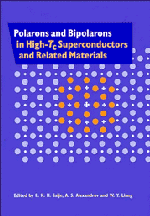Book contents
- Frontmatter
- Contents
- Preface
- 1 A polaron theory of high-temperature superconductors
- 2 On the possibility of non-BCS superconductivity
- 3 A bipolaron Bose liquid in high-Tc superconductors
- 4 Spin polarons in high-Tc superconductors
- 5 The polaron scenario for high-Tc superconductors
- 6 Formation, phase separation and superconductivity of large bipolarons
- 7 Polarons and bipolarons in WO3−x and YBa2Cu3O7
- 8 Polaron bands in the far- and mid-infrared spectra of e-doped cuprates
- 9 Electron–phonon interaction of non-equilibrium carriers in the photoinduced state of YBa2Cu3O7−δ
- 10 Experimental evidence of local lattice distortion in superconducting oxides
- 11 The Hall effect due to small polarons and conduction in narrow energy bands
- 12 Static and dynamic conductivity of untwinned Y1Ba2Cu4O8: gaps or condensation?
- 13 The near infrared and optical absorption of high- Tc superconductors using powders
- 14 Polaronic theory of mid-infrared conductivity: a numerical cluster study
- 15 Electromagnetic properties of local pair superconductors
- 16 Electron–hole asymmetric polarons
- 17 On the nature of the superconducting state in high-Tc cuprates
- 18 High- Tc superconductivity with polarons and bipolarons: an approach from the insulating states
- 19 Coexistence of small-polaron and Anderson localization in high- Tc superconducting materials
- 20 Concentration and temperature-dependence of magnetic polaron spectra in the t–J model
- 21 Mass enhancement without band-narrowing in t–t′–J and related models: predictions for Fermi-surface and optical conductivity
- 22 Polarons in Peierls–Hubbard models
- 23 Exact estimates of inter-polaron coupling constants resulting in bipolaron formation
- 24 Coulomb interaction and the criteria for bipolaron formation
- 25 Large bipolarons and high-Tc materials
- 26 Collective excitations in the ground state of a two-dimensional attractive Fermi gas
- 27 Strong two-band electron self-trapping, state hybridization effects and related pressure-induced phenomena in semiconductors
- 28 Bismuth disproportionation in super- and semiconducting barium bismuthates
- 29 Magnetic polarons in concentrated and diluted magnetic semiconductors
- 30 Energy scales of exotic superconductors
- Index
13 - The near infrared and optical absorption of high- Tc superconductors using powders
Published online by Cambridge University Press: 24 November 2009
- Frontmatter
- Contents
- Preface
- 1 A polaron theory of high-temperature superconductors
- 2 On the possibility of non-BCS superconductivity
- 3 A bipolaron Bose liquid in high-Tc superconductors
- 4 Spin polarons in high-Tc superconductors
- 5 The polaron scenario for high-Tc superconductors
- 6 Formation, phase separation and superconductivity of large bipolarons
- 7 Polarons and bipolarons in WO3−x and YBa2Cu3O7
- 8 Polaron bands in the far- and mid-infrared spectra of e-doped cuprates
- 9 Electron–phonon interaction of non-equilibrium carriers in the photoinduced state of YBa2Cu3O7−δ
- 10 Experimental evidence of local lattice distortion in superconducting oxides
- 11 The Hall effect due to small polarons and conduction in narrow energy bands
- 12 Static and dynamic conductivity of untwinned Y1Ba2Cu4O8: gaps or condensation?
- 13 The near infrared and optical absorption of high- Tc superconductors using powders
- 14 Polaronic theory of mid-infrared conductivity: a numerical cluster study
- 15 Electromagnetic properties of local pair superconductors
- 16 Electron–hole asymmetric polarons
- 17 On the nature of the superconducting state in high-Tc cuprates
- 18 High- Tc superconductivity with polarons and bipolarons: an approach from the insulating states
- 19 Coexistence of small-polaron and Anderson localization in high- Tc superconducting materials
- 20 Concentration and temperature-dependence of magnetic polaron spectra in the t–J model
- 21 Mass enhancement without band-narrowing in t–t′–J and related models: predictions for Fermi-surface and optical conductivity
- 22 Polarons in Peierls–Hubbard models
- 23 Exact estimates of inter-polaron coupling constants resulting in bipolaron formation
- 24 Coulomb interaction and the criteria for bipolaron formation
- 25 Large bipolarons and high-Tc materials
- 26 Collective excitations in the ground state of a two-dimensional attractive Fermi gas
- 27 Strong two-band electron self-trapping, state hybridization effects and related pressure-induced phenomena in semiconductors
- 28 Bismuth disproportionation in super- and semiconducting barium bismuthates
- 29 Magnetic polarons in concentrated and diluted magnetic semiconductors
- 30 Energy scales of exotic superconductors
- Index
Summary
Abstract
The near infrared and optical absorption of several high-Tc superconductors is investigated using the KBr powder method. The spectra show broad NIR absorption peaks. Examples of absorption spectra obtained using transmission data of thin film work for Ba1−xKxBiO3 (BKB) and single-crystal measurements for Bi2Sr2Ca1−xYxCu2O8+δ (BSCC) are given for comparison. They confirm the results of the KBr spectra. An example of similar investigations on NiO also shows good agreement over the whole spectral range under investigation. These facts provide some evidence that the line profiles deduced by the KBr technique may indicate a correct absorption line shape. A possible explanation of the NIR line profile is discussed.
Introduction
The absorption of various high- Tc systems measured using Kubelka-Munk [1, 2] or standard KBr powder techniques [3–7] is known to possess broad peaks in the near infrared spectral range. Similar features have earlier been discussed in connection with a small-polaron absorption mechanism in the non-stoichiometric compounds of systems like TiO2−x [8], WO3−x [9], NbO2.5−x [10,11] and the ternary compounds NbxW1−xOy [12]. For the superconductors of the system YBa2Cu3O7−δ, La2CuO4+δ and Bi2Sr2CaCu2O8+δ [3–5] it has been shown that the NIR absorption cross-sections increase approximately linearly with decreasing temperature down to the superconducting transition temperatures (Tc). Below Tc the slope decreases to smaller values. Dewing et al. [3, 4] have explained this effect as evidence for Bose–Einstein condensation of small bipolarons for YBa2Cu3O7.
- Type
- Chapter
- Information
- Publisher: Cambridge University PressPrint publication year: 1995

